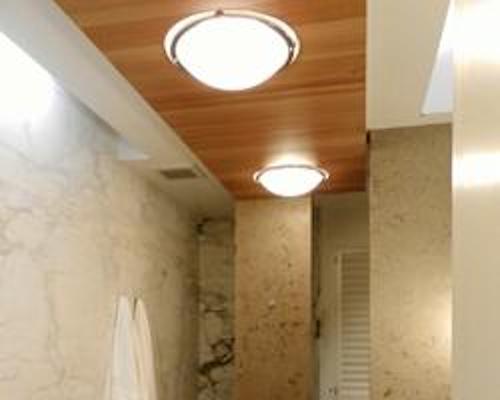Q: I'm dealing with a concrete ceiling in a condominium. If I use LED recessed lighting, do I still have to drop a 6-inch soffit? Someone told me that LED cans take up less space than traditional incandescent cans.
A: Your main challenge here is the concrete ceiling. What the contractors usually do is drop a ceiling or soffit in the kitchen or a hallway in order to provide space for recessed fixtures. Then they throw a couple of track runs for the rest of the space. Yes, there are shallower LED recessed fixtures, but they don't have to be LED. Low voltage fixtures with remote transformers can also be quite shallow, and they can also accept an LED MR16.
Here's a thought: As an alternative to building soffits, you might consider installing floating ceiling panels. There are companies such as Armstrong that make modular suspended wood ceilings. Or you could make them from painted modified density fiberboard (MDF) or have an applied wood veneer. It would be best if these panels could be located such that they float over an existing junction box. Otherwise, you'll need to do some surface wiring in order to get the power where you need it.
If you go this route, you can also install a run of perimeter dimmable LED lighting. Then you are not only providing accent light from the recessed fixtures, but also a lovely layer of ambient light for the room from the indirect lighting flowing out from above the suspended panels. Please forgive me for going way beyond a simple answer to your question. I'm on a double latte high.
Related Question
Q: I am changing the old fluorescent tubes in my kitchen to new recessed LED lights. My original estimate included the installation of 6-inch cans, trim and lights, but now the electrician tells me that he no longer uses cans. He is now installing lights directly into junction boxes. I realize this reduces costs for him, but there isn't an "airtight" option with J-box installation like there is with cans. Is that an important consideration? Also, would the absence of a can affect my ability to change the fixtures in the future?
A: What your electrician is suggesting is a surface-mounted fixture that is about the size of a dessert plate. It uses an LED source, which is dimmable. My main concern about this type of fixture is that is does produce quite a bit of glare. A more traditional recessed fixture does a much better job of hiding the light source. Using an airtight recessed fixture does keep heating and air conditioning from being lost through the openings created by the installation of recessed fixtures. The shallow LED "dessert plates" are airtight since they do not pierce the ceiling. You could easily change out these fixtures to another surface-mounted fixture or a pendant-mounted fixture from the existing J-box.
My recommendation, though, is to go to a more traditional recessed airtight fixture that uses an LED source. You want to pick one where the lens that hides the LED diodes is regressed back into the fixture so that it is not flush with the ceiling plane. There are a lot of manufacturers out there. I would recommend that you find one that has a warm color temperature (2700K), has a good lumen output (the equivalent of a 75W reflector bulb or better) and is dimmable. Take a look at the Cree CR4 and CR6, which fit into most 4-inch and 6-inch housings. I also like the WarmDim by Juno, where the LED lighting appears to get warmer as it is dimmed.







